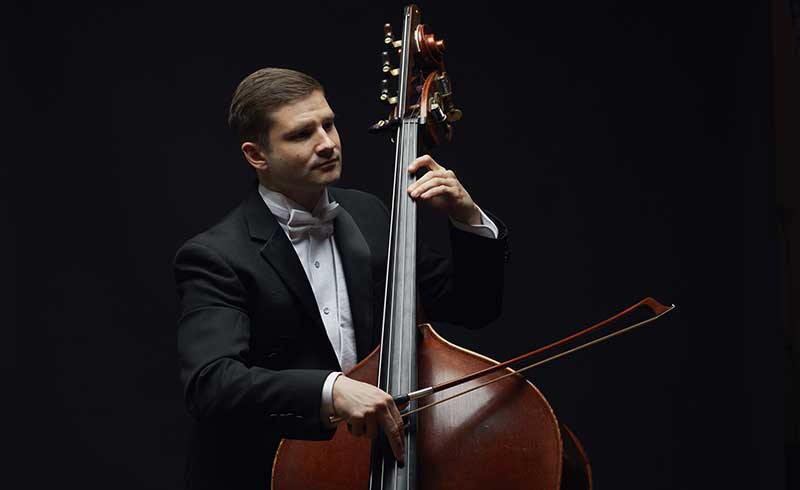
October 18, 2020
Live from Jones Hall Q&A: Robin Kesselman, Principal Double Bass, on Mazzoli’s “Dark with Excessive Bright”
On Saturday, August 22, members of the Houston Symphony continue the livestream concert series Live from Jones Hall with an evening of two pieces by Mozart, as well as a double bass concerto by a composer described as “Brooklyn’s post-millennial Mozart,” Missy Mazzoli.
Robin Kesselman, principal double bass, takes on the piece entitled Dark with Excessive Bright—a phrase borrowed from Milton’s Paradise Lost, meant as a description of the sound of the double bass. Robin discusses the work, which he says is an “instant classic,” ahead of the performance.
Watch Robin perform an excerpt:
What does it mean to you to spotlight the double bass in this way?
This is a spectacular opportunity for the instrument. All double bass players feel a responsibility to show those outside of our community what we already know, which is that it is a wonderful solo instrument. It’s special for audience members to get to hear this firsthand.
Do you agree with the composer’s description of the sound of the double bass as “Dark with Excessive Bright”?
Robin Kesselman: Absolutely, she’s speaking to the wide range of colors across the full spectrum of the instrument’s range. The highest area of the double bass has a pointedly focused color, an almost reedy brightness. Mazzoli also utilizes the rich, dark chocolate of the low end beautifully.
How would you characterize this concerto, and Mazzoli’s work in general?
Robin Kesselman: She is a leading figure in the American musical landscape: Missy was one of the first two female composers ever commissioned by the Metropolitan Opera, and she’s composer in residence at the Chicago Symphony. There’s a free and conversational style to her melodic writing. It’s very lyrical and simultaneously intricate and interesting in construction.
This piece was specifically written for Maxime Bibeau, the principal bass of the Australian Chamber Orchestra. He plays on one of the oldest and most famous double bass instruments played today—it was made in the 16th century by Gasparo da Salo. The composer explores the idea of the instrument itself as a knowledgeable storyteller communicating its own centuries-old experiences. For me, I’m playing more of a modern bass, so the way I’ve approached the interpretation is by thinking of the history of my teachers, and their teachers’ teachers history—the pedagogical history of playing that is embedded in all players, passed on from teacher to student over multiple generations. All performers feel a connection to history, whether it’s the music we play or where and how our own styles originated.
What has been challenging in preparing this piece? Do you have a favorite part?
Robin Kesselman: We’re so lucky to have a composer of this magnitude compose for the instrument. It’s an instant classic and a massive addition to our repertoire. It sits really high for a long time, it’s done in an artful and beautiful way—but it’s an area of the instrument where having a committed sound and vibrato is a lot of work!
What do you hope the audience walks away feeling after they hear this concerto?
Robin Kesselman: I hope that they get swept up into the sound world and story that Mazzoli set out to tell with these instrumental forces. It’s not a technical exercise, or a chance to hear me personally—we’re conduits stepping out to communicate her vision.
Watch live! Join Robin and members of the Houston Symphony for the Live from Jones Hall livestream concert on Saturday, August 22, at 8 p.m. central. Tickets are $10.






